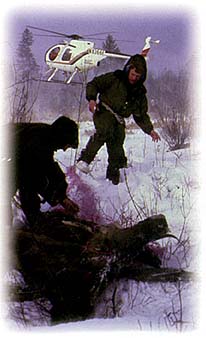![]()

 A
dragonfly sans wings, the helicopter sits on the flatbed truck, its work
done.
A
dragonfly sans wings, the helicopter sits on the flatbed truck, its work
done.
On this sunny, snow-covered late winter day, mechanic Kelly Doles is tending to the beast, making sure all is well before moving on to the next wildlife roundup.
by Dennis Walikainen
This particular day signaled the end of radio-collaring of the Upper Peninsula's moose population. And the aerial heart and soul of the operation was being prepped for its next journey.
Meanwhile, at Michigan Tech, Associate Professor of Mathematics Tom Drummer is crunching the numbers of the moose census for Michigan's Department of Natural Resources.
Drummer's work will help estimate the number of moose in Baraga, Houghton, and Marquette Counties.
And he gets to fly, too.
"It's not a simple task," he says, excitedly recounting his airborne days. "You're going about 120 mph, there's diesel fumes, you're changing directions constantly, and there are no doors!"
"I sometimes get queasy the first time up, but then I am usually okay."
Drummer's place on the helicopter is sometimes taken up by mechanic Doles or some other unsuspecting soul, like DNR photographer Dave Kenyon, who lost the proverbial cookies the day before we saw him and the rest of the moose trackers.
"Poor Dave," was the general joking theme of the media meeting.
Pilot Stuart Feaver and net gunner Jeff Carter don't have such problems. But then, with 11,000 hours of flying time in every conceivable terrain and weather condition from their native New Zealand to Alberta, Canada, to Alberta, U.P., they have some experience on their side.
At their side, they have a shotgun loaded with a huge, orange net to corral the moose. It is a system that works much better than tranquilizing, according to Drummer.
"There is some stress on the animal," he says, "but there is more danger for the handler."
A typical capture, if there is such a thing, goes something like this:
1. herding a moose, via the helicopter, out from the cover of trees into an open area,
2. shooting the net out of the gun to cover the animal,
3. jumping down from the helicopter as it is hovering (and, in the winter, blowing snow everywhere),
4. lashing the front legs to the back legs,
5. trying not to get killed by the 1,000-pound beast,
6. putting a collar on and/or doing medical tests, and
7. unlashing, un-netting, and getting out of the way.
The problems are myriad.
The moose get bedded down and are incredibly hard to find, even in the open where "they resemble huge fallen-down trees."
Less expense, easier, and more efficient
The helicopter is also much more inexpensive than doing it on foot. At $1,000 per animal, the twenty-six that were tagged in the Western (and Eastern) U.P. were a bargain compared to the usual technique of tranquilizing animals with a dart gun. The darts cost $300 each and missed shots are common.
Either way, "you better be a really good shot," Drummer exclaims.
And you better not call them cowboys.
While talking to Feaver and Carter, they didn't appreciate the snowstorm roundup analogy.
"We're not cowboys," Feaver retorts in his New Zealand brogue, casting steely blue eyes toward the interviewer, "We work for a living!"
And what is gained from all this hard work?
"We'll be able to tell the DNR what the numbers are, what their health is like, what the sex ratio is," Drummer stresses, adding that the numbers have risen dramatically since the 1985 and 1987 reintroduction of the moose to the U.P.
There are approximately 500 of the animals here now, with 350 of them in the Central U.P.
More-firm numbers will arise from a census count later this winter, according to Drummer.
"The three years of collaring animals has allowed us to estimate the number of moose in the area," he says. "We've actually seen approximately 40 percent of the animals, and the study this winter, from the fixed-wing aircraft, will help us adjust the estimate."
Fixed wing?
"It won't be as exciting as the helicopter," Drummer chuckles, "but it will still be fun."
Flying with Drummer will be Rob Aho of the Michigan Department of Natural Resources, who contracted with Drummer to run the numbers of the census.
The flights that began in December will help with the moose head count and will also prove the accuracy of the radio collaring and sampling.
"It will also help us reduce the dependence on the radio collaring," Aho says. "Since the helicopter work, some of the moose have died, and the number of the sample, a half-dozen, might not be a true representation of the herd.
Reproduction rates are especially hard to predict, Aho says. Some moose just aren't as active, and their distribution, 452 animals over a massive area, makes "low and slow" flyovers a necessity to garner accurate numbers.
Residents of the Upper Peninsula don't help much.
"There was a recent encounter with a moose in Keweenaw County, which is still rare," Aho says, "and of the twenty people who saw him, only one thought to call us, and he didn't tell the others he was going to do so."
Workers like Drummer are more reliable. He is volunteering his time to go airborne this winter, because his contract with the DNR has run out.
"He's a great guy to have in the cockpit of an airplane," Aho says of Drummer. "He's affable, tells jokes, and I've really enjoyed being associated with him over these past ten years."
Numbers crunchers, it seems, can have fun, too, even if it means bouncing around just above the trees trying to count the elusive Yooper moose.
![]()